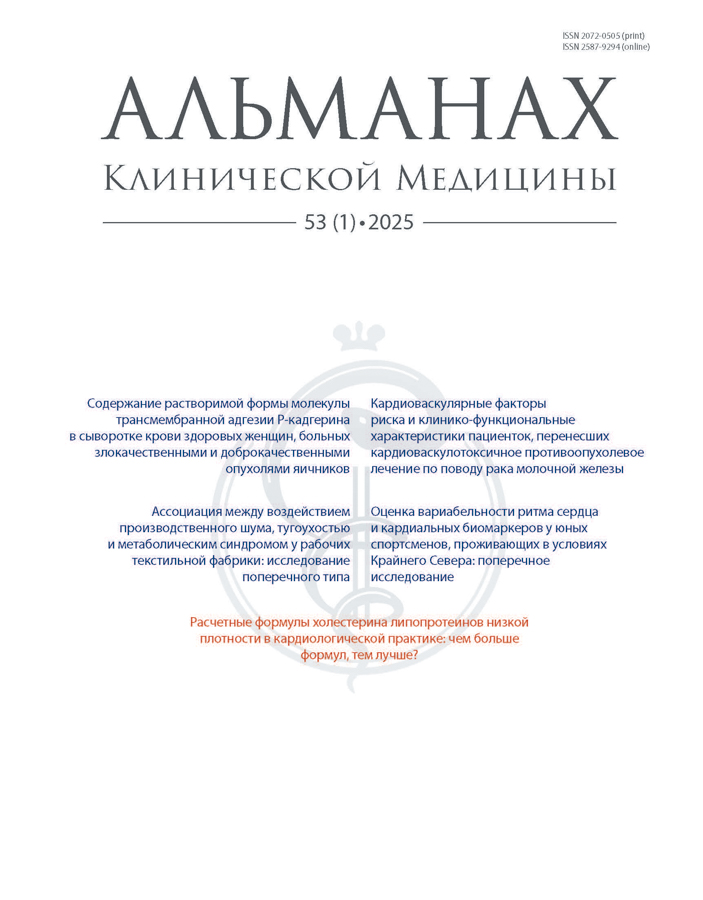Применение искусственного интеллекта для анализа медицинских данных
- Авторы: Бурсов А.И.1
-
Учреждения:
- ФГБУН Институт системного программирования им. В.П. Иванникова РАН
- Выпуск: Том 47, № 7 (2019)
- Страницы: 630-633
- Раздел: ТОЧКА ЗРЕНИЯ
- URL: https://almclinmed.ru/jour/article/view/1190
- DOI: https://doi.org/10.18786/2072-0505-2019-47-071
- ID: 1190
Цитировать
Полный текст
Аннотация
Искусственный интеллект (ИИ) и машинное обучение успешно применяются в медицине и решают широкий круг задач, постепенно превращаясь из вспомогательного инструмента в хороших помощников медицинского персонала. В основе работы ИИ лежит анализ медицинских данных и их обработка по заданным алгоритмам. В настоящее время анализируются не только данные объективного осмотра и анамнеза пациента, но и результаты анализов и обследований на медицинском оборудовании. Применение подобных инструментов повышает эффективность врача, избавляя его от выполнения ряда рутинных операций, таких как ведение части медицинской документации и описание нормы при проведении обследований. Одна из значимых проблем применения ИИ в медицине – подготовка корректных медицинских данных для обучения алгоритмов, так как для этого требуется большое количество времени специалистов узкого профиля. Возможным решением видится создание объединенной платформы хранения медицинских данных, где врачи смогут готовить данные для применения ИИ в своей специальности. Это позволит в будущем повысить эффективность применения машинного обучения в медицине благодаря анализу разноплановых данных из различных источников.
Ключевые слова
Об авторах
А. И. Бурсов
ФГБУН Институт системного программирования им. В.П. Иванникова РАН
Автор, ответственный за переписку.
Email: bursov@ispras.ru
Бурсов Андрей Игоревич - советник по информационным технологиям в медицине и здравоохранении.
109004, Москва, ул. А. Солженицына, 25, тел.: +7 (495) 912 46 14
РоссияСписок литературы
- Mintz Y, Brodie R. Introduction to artificial intelligence in medicine. Minim Invasive Ther Allied Technol. 2019;28(2):73–81. doi: 10.1080/13645706.2019.1575882.
- Amisha, Malik P, Pathania M, Rathaur VK. Overview of artificial intelligence in medicine. J Family Med Prim Care. 2019;8(7):2328–31. doi: 10.4103/jfmpc.jfmpc_440_19.
- Choy G, Khalilzadeh O, Michalski M, Do S, Samir AE, Pianykh OS, Geis JR, Pandharipande PV, Brink JA, Dreyer KJ. Current applications and future impact of machine learning in radiology. Radiology. 2018;288(2):318–28. doi: 10.1148/radiol.2018171820.
- Panzarasa S, Quaglini S, Micieli G, Marcheselli S, Pessina M, Pernice C, Cavallini A, Stefanelli M. Improving compliance to guidelines through workflow technology: implementation and results in a stroke unit. Stud Health Technol Inform. 2007;129(Pt 2):834–9.
- Forghani R, Chatterjee A, Reinhold C, PérezLara A, Romero-Sanchez G, Ueno Y, Bayat M, Alexander JWM, Kadi L, Chankowsky J, Seuntjens J, Forghani B. Head and neck squamous cell carcinoma: prediction of cervical lymph node metastasis by dual-energy CT texture analysis with machine learning. Eur Radiol. 2019;29(11):6172–81. doi: 10.1007/s00330-019-06159-y.
- Aeffner F, Zarella MD, Buchbinder N, Bui MM, Goodman MR, Hartman DJ, Lujan GM, Molani MA, Parwani AV, Lillard K, Turner OC, Vemuri VNP, Yuil-Valdes AG, Bowman D. Introduction to digital image analysis in whole-slide imaging: a white paper from the digital pathology association. J Pathol Inform. 2019;10:9. doi: 10.4103/jpi.jpi_82_18.
- Roach L. Artificial Intelligence. EyeNet Magazine. 2017;11:77–83.
- Padhy SK, Takkar B, Chawla R, Kumar A. Artificial intelligence in diabetic retinopathy: A natural step to the future. Indian J Ophthalmol. 2019;67(7):1004–9. doi: 10.4103/ijo.IJO_1989_18.
- Hsieh JC, Hsu MW. A cloud computing based 12-lead ECG telemedicine service. BMC Med Inform Decis Mak. 2012;12:77. doi: 10.1186/1472-6947-12-77.
- Goumopoulos C. A high precision, wireless temperature measurement system for pervasive computing applications. Sensors (Basel). 2018;18(10):3445. doi: 10.3390/s18103445.
- Yetisen AK, Martinez-Hurtado JL, Ünal B, Khademhosseini A, Butt H. Wearables in Medicine. Adv Mater. 2018;30(33):e1706910. doi: 10.1002/adma.201706910.
- Benke K, Benke G. Artificial intelligence and big data in public health. Int J Environ Res Public Health. 2018;15(12):2796. doi: 10.3390/ijerph15122796.
- Chen PH. Essential elements of natural language processing: what the radiologist should know. Acad Radiol. 2019;S1076–6332(19): 30417–9. doi: 10.1016/j.acra.2019.08.010.
- Garg R, Oh E, Naidech A, Kording K, Prabhakaran S. Automating ischemic stroke subtype classification using machine learning and natural language processing. J Stroke Cerebrovasc Dis. 2019;28(7):2045–51. doi: 10.1016/j.jstrokecerebrovasdis.2019.02.004.
- Powell ME, Rodriguez Cancio M, Young D, Nock W, Abdelmessih B, Zeller A, Perez Morales I, Zhang P, Garrett CG, Schmidt D, White J, Gelbard A. Decoding phonation with artificial intelligence (DeP AI): Proof of concept. Laryngoscope Investig Otolaryngol. 2019;4(3):328–34. doi: 10.1002/lio2.259.
- Wu H, Soraghan J, Lowit A, Di Caterina G. Convolutional neural networks for pathological voice detection. Conf Proc IEEE Eng Med Biol Soc. 2018;2018:1–4. doi: 10.1109/EMBC.2018.8513222.
- Slavich GM, Taylor S, Picard RW. Stress measurement using speech: Recent advancements, validation issues, and ethical and privacy considerations. Stress. 2019;22(4):408–13. doi: 10.1080/10253890.2019.1584180.
- König A, Linz N, Zeghari R, Klinge X, Tröger J, Alexandersson J, Robert P. Detecting apathy in older adults with cognitive disorders using automatic speech analysis. J Alzheimers Dis. 2019;69(4):1183–93. doi: 10.3233/JAD-181033.
- Sun O, Chen J, Magrabi F. Using voice-activated conversational interfaces for reporting patient safety incidents: A technical feasibility and pilot usability study. Stud Health Technol Inform. 2018;252:139–44.
- Хау Дж. Краудсорсинг. Коллективный разум как инструмент развития бизнеса. М.: Альпина Паблишер; 2012. 288 с.
- BGU researchers first to show how hackers can dupe radiologists and A.I. software by manipulating lung cancer scans. Ben-Gurion University of the Negev. 04.09.2019 [Internet]. Available from: https://in.bgu.ac.il/en/pages/news/scans_hacking.aspx.
Дополнительные файлы








